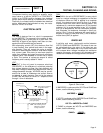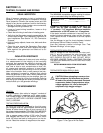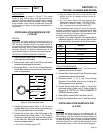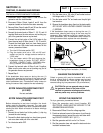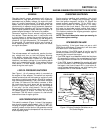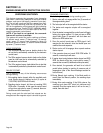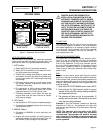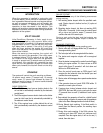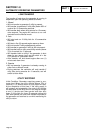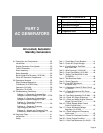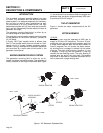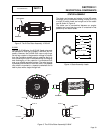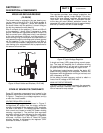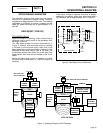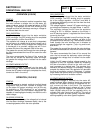
GENERAL INFORMATION
SECTION 1.8
AUTOMATIC OPERATING PARAMETERS
PART 1
Page 29
INTRODUCTION
When the generator is installed in conjunction with
a transfer switch, either manual or automatic opera-
tion is possible. Manual transfer and engine startup,
as well as manual shutdown and re-transfer are
covered in Section 1.7. Selection of fully automatic
operation is also discussed in that section. This
section will provide a step-by-step description of the
sequence of events that will occur during automatic
operation of the system.
UTILITY FAILURE
Initial Conditions: Generator in Auto, ready to run,
load being supplied by utility source. When utility
fails (below 65% of nominal), a 10 second (optionally
programmable on the 17 and 20 kW only) line inter-
rupt delay time is started. If the utility is still gone
when the timer expires, the engine will crank and
start. Once started, a five (5) second engine warmup
timer will be initiated.
When the warm-up timer expires, the control will
transfer the load to the generator. If the utility power
is restored (above 75% of nominal) at any time from
the initiation of the engine start until the generator
is ready to accept load (5 second warm-up time has
not elapsed), the controller will complete the start
cycle and run the generator through its normal cool
down cycle; however, the load will remain on the utility
source.
CRANKING
The system will control the cyclic cranking as follows:
16 second crank, seven (7) second rest, 16 second
crank, seven (7) second rest followed by three (3)
additional cycles of seven (7) second cranks followed
by seven (7) second rests.
CHOKE OPERATION:
1. The 990/999cc engines have an electric choke in the
air box that is automatically controlled by the electronic
control board.
2. The 530cc engines have an electric choke on the divider
panel air inlet hose that is automatically controlled by
the electronic control board.
3. The 410cc engines have a choke behind the air box
that is automatically controlled by the electronic control
board.
FAILURE TO START:
This is defined as any of the following occurrences
during cranking.
1. Not reaching starter dropout within the specified crank
cycle. Starter dropout is defined as four (4) cycles at
1,000 RPM.
2. Reaching starter dropout, but then not reaching 2200
RPM within 15 seconds. In this case the control board
will go into a rest cycle for seven (7) seconds, then
continue the rest of the crank cycle.
During a rest cycle the start and fuel outputs are
de-energized and the magneto output is shorted to
ground.
CRANKING CONDITIONS:
The following notes apply during cranking cycle.
1. Starter motor will not engage within five (5) seconds of
the engine shutting down.
2. The fuel output will not be energized with the starter.
3. The starter and magneto outputs will be energized
together.
4. Once the starter is energized the control board will begin
looking for engine rotation. If it does not see an RPM
signal within three (3) seconds it will shut down and
latch out on RPM sensor loss.
5. Once the control board sees an RPM signal it will
energize the fuel solenoid, drive the throttle open and
continue the crank sequence.
6. Starter motor will disengage when speed reaches starter
dropout.
7. If the generator does not reach 2200 RPM within 15
seconds, re-crank cycle will occur.
8. If engine stops turning between starter dropout and
2200 RPM, the board will go into a rest cycle for seven
(7) seconds then re-crank (if additional crank cycles
exist).
9. Once started, the generator will wait for a holdoff period
before starting to monitor oil pressure and oil temperature
(refer to the Alarm Messages section for hold-off times).
10. During Manual start cranking, if the Mode switch is
moved from the Manual position, the cranking stops
immediately.
11. During Auto mode cranking, if the Utility returns, the
cranking cycle does NOT abort but continues until
complete. Once the engine starts, it will run for one (1)
minute, then shut down.



